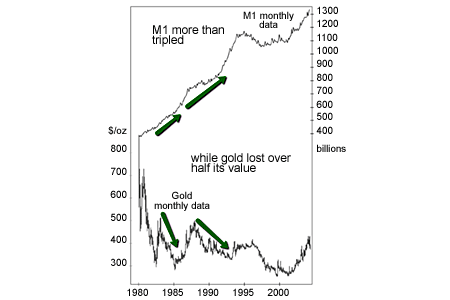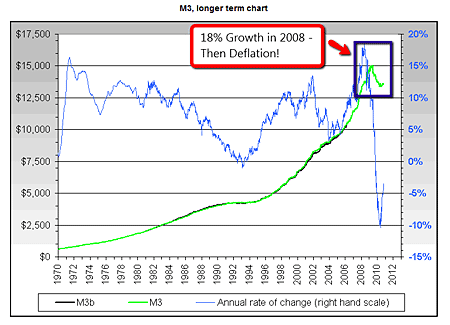Is gold really an inflation hedge?
The conventional view is that gold is a hedge against inflation, and the price will continue to rise for some time. But is that really the case? And if it's not, how can we use that fact to make profitable trades?
Yes, I know I bang on a lot about gold. But gold is popular right now. And that spells opportunity for anyone like me, who likes to bet against the crowd.
The fact is that a contrary approach can, with good timing, provide us with relatively quick not to mention huge profits. When a bubble bursts, it happens in a flash compared with the time taken to inflate it.
So I'd like to examine the widely held view that gold is a reliable hedge against weakening currencies (decreasing buying power).
MoneyWeek
Subscribe to MoneyWeek today and get your first six magazine issues absolutely FREE

Sign up to Money Morning
Don't miss the latest investment and personal finances news, market analysis, plus money-saving tips with our free twice-daily newsletter
Don't miss the latest investment and personal finances news, market analysis, plus money-saving tips with our free twice-daily newsletter
What is inflation?
First, let's look at the concept of 'inflation'. The word is bandied about a lot, but there is much confusion here. We must distinguish between cost of living measures and the classic definition.
In the study of economics, inflation is simply a measure of the increase of money and credit in the economy. Note the word 'credit'. It plays a big part in our credit-based economies much more so than the amount of money in the system. This is because of our fractional banking system a bank deposit can be lent out to a borrower magnified several times over.
This borrower therefore has a debt to the bank, which then owns the corresponding credit on its balance sheet. Because the sum of these credits far exceeds the money on deposit, it is at risk from defaults by the borrowers.
The bank's job is to lend to willing (and qualified) borrowers. A healthy economy is one where companies' borrowings are used for productive endeavours, filling orders, employing the workforce, paying taxes, and so on. An unhealthy economy is one where the borrowings are used to keep the company afloat, to pay redundancies, and so on.
In both scenarios, the money supply and credit may be increasing. But in the first case, there is an increasing demand for goods and services, leading to a higher cost of living, while in the second case, aggregate demand is falling, leading to a subdued cost of living (this is the period we are currently in). Changes in the Consumer Price Index (CPI) are merely a secondary result of changes to money and credit.
During periods of high CPI inflation, money loses value rapidly, and to compensate, interest rates are generally high, as demand for money and credit is expanding. The situation is reversed during contractions.
The role of gold
For centuries, as gold bugs are fond of telling us, gold has kept its value in terms of purchasing power. Quite possibly, a Roman toga cost the same in gold as a suit does today. But for timeframes that are of interest to us (months and years), has the price of gold always tracked consumer prices or the money supply?
Here is a chart of the money supply plotted against gold since 1980, which reveals some very interesting features:

Chart courtesy of elliottwave.com
During the 1970s, inflation was rampant and gold duly rallied to more than $850 at its peak. Then in 1980, the gold price fell heavily to a low of under $300 in 1985 all the while, M1 (the sum of physical currency in bank reserves plus current accounts) almost doubled. Inflation was still high.
We had a similar effect starting in 1988, when gold fell from a high of $500 to a low of $260 in 2002 (where our arch-trader Gordon Brown sold most of the UK's gold supply). Yet meanwhile, M1 almost tripled! Money was freely available to anyone wanting to push up the price of gold. But guess what? The demand for gold wasn't there. I recall an overwhelmingly negative attitude to the metal at the time (that was the time to buy, of course).
During these periods, the inflation story disappointed a lot of gold bulls. So history shows once again, that clinging to an old dogma can cost dear. As with all things, an idea is valid only according to context and you need to get in early, not late in the day.
We have in recent years seen another massive increase in the Gold price, accompanied by huge increases in the money supply. Here is the gold price since 1975, showing the 1980 spike:


(We've used M3 here this is a broader measure of the money supply than M1).
This year, the money supply is starting to fall (the rate of change is shown in the chart), and the gold price is arguably wobbling. Perhaps it has discounted fully the inflation story. But the clamour of people trying to sell you gold grows by the day. That should be a big warning for traders.
I shall be looking to short this market as I anticipate big and rapid falls ahead. The chart shows we are potentially at the tip of a huge spike. But notice the spike to the 1980 high. The market first fell sharply, then rallied sharply before falling hard. As traders, we ideally want to be selling on that second rally.
I expect to feature gold trades frequently in my blog posts.
Get the latest financial news, insights and expert analysis from our award-winning MoneyWeek team, to help you understand what really matters when it comes to your finances.
John is is a British-born lapsed PhD physicist, who previously worked for Nasa on the Mars exploration team. He is a former commodity trading advisor with the US Commodities Futures Trading Commission, and worked in a boutique futures house in California in the 1980s.
He was a partner in one of the first futures newsletter advisory services, based in Washington DC, specialising in pork bellies and currencies. John is primarily a chart-reading trader, having cut his trading teeth in the days before PCs.
As well as his work in the financial world, he has launched, run and sold several 'real' businesses producing 'real' products.
-
 Investors will reap long-term rewards from UK equities
Investors will reap long-term rewards from UK equitiesOpinion Nick Train, portfolio manager, Finsbury Growth & Income Trust, highlights three UK equities where he’d put his money
-
 The graphene revolution is progressing slowly but surely
The graphene revolution is progressing slowly but surelyEnthusiasts thought the discovery that graphene, a form of carbon, could be extracted from graphite would change the world. They might've been early, not wrong.